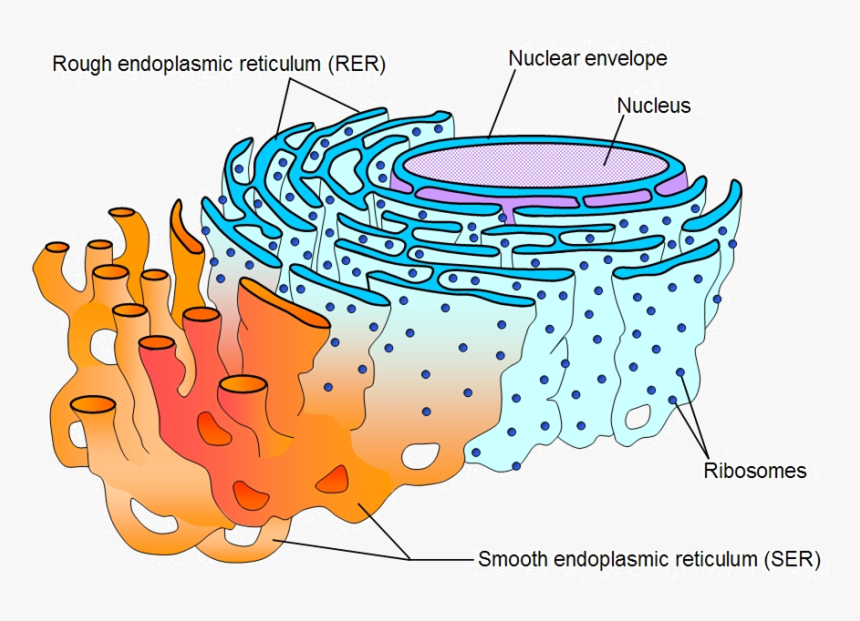Endoplasmic Reticulum Types: Rough vs Smooth Explained
Imagine a busy motorway system weaving through a bustling city—this is essentially how the endoplasmic reticulum (ER) navigates your cells. By connecting the nucleus to other parts of the cell, the ER ensures nutrients and proteins travel efficiently. Although it looks like a maze of membranes, the shape of endoplasmic reticulum gives it a massive surface area to handle essential tasks like protein folding and lipid synthesis. In many eukaryotic cells, it comes in two main forms—rough and smooth—each fine-tuned for different functions. Together, these types of endoplasmic reticulum form the perfect transport and production centre for vital cellular processes.
What is Endoplasmic Reticulum?
Endoplasmic Reticulum is a complex network of flattened sacs and tubular membranes found exclusively in eukaryotic cells. The ER extends from the nuclear envelope to the cell membrane, acting as a central highway for transporting proteins, lipids, and other biomolecules.
For more understanding on Cell Biology
Types of Endoplasmic Reticulum
The ER is broadly divided into two distinct forms:
Rough Endoplasmic Reticulum (RER)
Studded with ribosomes, giving it a “rough” appearance.
Specialises in protein synthesis, folding, and quality control.
Smooth Endoplasmic Reticulum (SER)
Lacks ribosomes, resulting in a smooth surface.
Involved in lipid synthesis, carbohydrate metabolism, and detoxification processes.
These types of endoplasmic reticulum continuously interconnect, ensuring swift communication and transport of materials within the cell.
Endoplasmic Reticulum Diagram

A visual representation is key to understanding how the ER is organised:
Rough ER Section
Flattened sacs called cisternae, each adorned with ribosomes.
The membrane connects seamlessly to the nuclear envelope.
Smooth ER Section
Tubular structures without ribosomes.
Often found near or intertwined with RER.
Structure of Endoplasmic Reticulum
The structure of endoplasmic reticulum can be likened to a folded sack or tubular mesh:
Rough ER Structure
Ribosomes attached to the cytosolic side.
Primarily found in cells with high protein production (e.g., liver cells).
Functions in protein folding, sorting, and export.
Smooth ER Structure
Primarily tubular, lacking ribosomes.
Responsible for synthesising phospholipids and cholesterol.
Contributes to hormone production and detoxification, especially in liver cells.
Endoplasmic Reticulum Function
Understanding endoplasmic reticulum function highlights its critical role in cellular maintenance:
Rough ER Functions
Protein Synthesis: Ribosomes on the rough ER synthesise proteins that may be secreted or embedded in cell membranes.
Protein Folding: Ensures newly made proteins fold into the correct three-dimensional structure.
Quality Control: Misfolded proteins are identified and targeted for degradation.
Smooth ER Functions
Lipid Synthesis: Produces essential phospholipids and steroids.
Calcium Storage: Especially important in muscle cells for contraction and relaxation.
Detoxification: Breaks down harmful substances, like drugs and toxins.
Carbohydrate Metabolism: Assists in the conversion of glycogen to glucose in certain cells.
Interactive Quiz
Which organelle is directly connected to the endoplasmic reticulum?
What gives rough ER its “rough” appearance?
Which ER type is primarily involved in detoxification?
Name one major function of the rough endoplasmic reticulum.
True or False: Smooth ER helps in protein folding.
Check Your Answers Below:
The nuclear membrane
Ribosomes
Smooth ER
Protein synthesis (or protein folding, quality control)
False (Protein folding primarily occurs in rough ER)
Fun Facts About Endoplasmic Reticulum
Dynamic Connections: The ER is constantly changing shape, extending, and retracting to meet cellular demands.
Proliferation in Stress: Cells produce more ER under stress, especially if protein folding is challenged.
Gigantic Surface Area: If stretched flat, the ER membrane could occupy a surprisingly large surface area—crucial for efficient transport.
Real-World Applications
Medical Therapeutics: Drug detoxification processes in the liver heavily rely on SER activity.
Protein Production: Industries leverage the knowledge of RER for large-scale protein synthesis (e.g., insulin production).
Disease Research: Malfunctions in ER (like protein misfolding) are linked to conditions such as Alzheimer’s and cystic fibrosis.


FAQs on Endoplasmic Reticulum: Structure, Functions & Importance
1. What is endoplasmic reticulum?
It is a network of tubular membranes in eukaryotic cells, crucial for protein and lipid production.
2. Why is the shape of endoplasmic reticulum important?
Its extensive folded structure increases surface area, boosting efficiency in transport and synthesis.
3. Which types of endoplasmic reticulum exist?
Rough endoplasmic reticulum (with ribosomes) and smooth endoplasmic reticulum (lacking ribosomes).
4. How does rough ER differ from smooth ER?
Rough ER hosts ribosomes for protein synthesis, while smooth ER focuses on lipid production and detoxification.
5. Where is the endoplasmic reticulum located?
It extends from the nucleus throughout the cytoplasm, linking up with other organelles.
6. Is there an endoplasmic reticulum diagram for easy reference?
Yes. Visuals typically show two sections: rough ER connected to the nucleus and smooth ER branching off.
7. What is the main endoplasmic reticulum function in cells?
The ER primarily synthesises proteins and lipids, plus stores and transports these molecules throughout the cell.
8. Which cells lack endoplasmic reticulum?
Certain specialised cells, like red blood cells and sperm cells, have little to no ER.
9. Why is the ER called a transport system?
It carries materials from the nucleus to other parts of the cell, akin to highways in a city.
10. How can I further explore the structure of endoplasmic reticulum?
Refer to detailed diagrams, 3D animations, or biology resources like [Insert Vedantu URL here] for more information.










